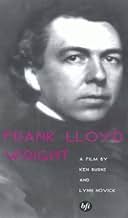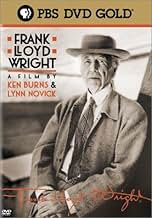A biography of the life and work of the American architect.A biography of the life and work of the American architect.A biography of the life and work of the American architect.
- Nominated for 1 Primetime Emmy
- 3 wins & 2 nominations total
Edward Herrmann
- Narrator
- (voice)
- Directors
- Writer
- All cast & crew
- Production, box office & more at IMDbPro
Featured reviews
I think the thing to remember about this documentary is that it's called "Frank Lloyd Wright," not "The Buildings of Frank Lloyd Wright." There are many other resources for those wishing to learn about his designs and the structures he built. (A personal recommendation is the 2002 documentary, "Restoration of Frank Lloyd Wright's Heurtley House").
The format that Ken Burns's films use is well known by now: pans of many still photographs, informative narration -- often jam-packed with facts but clearly presented and in a generally objective tone. Shifts in time and place are smoothly integrated such that it's unlikely that an attentive viewer will get lost.
Frank Lloyd Wright died in 1959 at age 91, and there were very few years in his long life that were not without controversy. He broke all kinds of rules with his architectural designs to create some truly remarkable structures -- "Fallingwater," the Johnson Wax Building in Racine, Wisconsin, the Imperial Hotel in Tokyo and most especially the Guggenheim Museum in New York. They are all examples of his iconoclasm. They and other structures sealed his reputation as the most famous American architect of his or any other generation. But it was the personal scandals, generally involving other men's wives, that forced him to flee the country on a number of occasions, and put his career in a deep freeze for long spells.
By his own admission Wright was an absent and negligent father to his many children; he seems to have been serially unfaithful until late middle age, and he was wild and extravagant with money -- particularly other people's. Clips from a 1958 TV interview with a chain-smoking Mike Wallace are interspersed throughout, and a snippet of it concludes the documentary with Wright proclaiming his immortality. Wright the man seems to have been insufferable, and he seems to have gotten little joy out of life.
Yet his doesn't appear to have been a tortured soul; his personal life may have been absent any harmony, and yet that quality repeatedly found its way into his work. Many of Wright's buildings are in breathtaking concert with nature. His interior designs, including that of the Unity Temple and almost all of his stained glass, suggest they are the creation of an unfettered and free spirit. Wright may have been such a man, but if so he directed those energies in many of the wrong places. His self-centeredness, arrogance and certainty of his genius hurt a lot of people around him.
It's well to ask why anyone wanted to work under him, and yet the waiting list for the scholarship program he operated at his Taliesin West studios in Arizona in the 1930s, 40s and 50s was a mile long. Students of Wright's were bent to his will; they had to do four hours' manual labor a day, grow their own food, submit to having their love relationships and even some marriages orchestrated by his wife, Olgivanna. The place was run like a boot camp, but the opportunity to work side by side with Wright was enough to keep the applications flowing in. Several graduates of the school are interviewed in the documentary, and for all of them working with Wright seems to have been the seminal experience of their lives -- they don't recall the hoops they had to jump through and the indignities they signed on for in order to have that privilege.
To truly love and appreciate the works of Frank Lloyd Wright, it's almost better if you don't know too much about their designer. Still, the dichotomy between the man and his sublime creations makes a great story, and this documentary is a largely successful attempt to bridge that gap.
The format that Ken Burns's films use is well known by now: pans of many still photographs, informative narration -- often jam-packed with facts but clearly presented and in a generally objective tone. Shifts in time and place are smoothly integrated such that it's unlikely that an attentive viewer will get lost.
Frank Lloyd Wright died in 1959 at age 91, and there were very few years in his long life that were not without controversy. He broke all kinds of rules with his architectural designs to create some truly remarkable structures -- "Fallingwater," the Johnson Wax Building in Racine, Wisconsin, the Imperial Hotel in Tokyo and most especially the Guggenheim Museum in New York. They are all examples of his iconoclasm. They and other structures sealed his reputation as the most famous American architect of his or any other generation. But it was the personal scandals, generally involving other men's wives, that forced him to flee the country on a number of occasions, and put his career in a deep freeze for long spells.
By his own admission Wright was an absent and negligent father to his many children; he seems to have been serially unfaithful until late middle age, and he was wild and extravagant with money -- particularly other people's. Clips from a 1958 TV interview with a chain-smoking Mike Wallace are interspersed throughout, and a snippet of it concludes the documentary with Wright proclaiming his immortality. Wright the man seems to have been insufferable, and he seems to have gotten little joy out of life.
Yet his doesn't appear to have been a tortured soul; his personal life may have been absent any harmony, and yet that quality repeatedly found its way into his work. Many of Wright's buildings are in breathtaking concert with nature. His interior designs, including that of the Unity Temple and almost all of his stained glass, suggest they are the creation of an unfettered and free spirit. Wright may have been such a man, but if so he directed those energies in many of the wrong places. His self-centeredness, arrogance and certainty of his genius hurt a lot of people around him.
It's well to ask why anyone wanted to work under him, and yet the waiting list for the scholarship program he operated at his Taliesin West studios in Arizona in the 1930s, 40s and 50s was a mile long. Students of Wright's were bent to his will; they had to do four hours' manual labor a day, grow their own food, submit to having their love relationships and even some marriages orchestrated by his wife, Olgivanna. The place was run like a boot camp, but the opportunity to work side by side with Wright was enough to keep the applications flowing in. Several graduates of the school are interviewed in the documentary, and for all of them working with Wright seems to have been the seminal experience of their lives -- they don't recall the hoops they had to jump through and the indignities they signed on for in order to have that privilege.
To truly love and appreciate the works of Frank Lloyd Wright, it's almost better if you don't know too much about their designer. Still, the dichotomy between the man and his sublime creations makes a great story, and this documentary is a largely successful attempt to bridge that gap.
10OGRE-8
After watching this film I cried knowing that prefection was attainable. For proof all you need do is look at the many buildings that are a testament to Frank Lloyd Wright's immortality.
I don't think I like Ken Burns very much. We are at cross purposes. He comes to give me a good story, tight with no lapses, that moves smoothly without holes. What I come for is insight, the holes, the spaces, the sight you get from emptiness. I cannot imagine a less suitable topic for the Burns approach than this particular mind.
He wants to tell the story of a genius, and like so many storytellers he constructs the man and assumes that as we know him, we will know his works, which are assumed to flow from his makeup. So we get a linear history: birth, life (a long one), death. Events happen and along the way out pops a building which we take the time to briefly visit. The passion of the man and indeed the transcendence of some of the spaces are conveyed not through firsthand cinematic experience, but through the passionate reporting of experts. I must admit their passion is contagious and they held my interest.
But there was no experience with the space. Apart from grand notions of unitarian communion with nature, no spatial ideas. We have a truly unfortunate decision, that architecture in the first moments is made analogous to music, the constructions being the same. Then when a spatial experience is expected, we get swelling of this and that classical piece; Beethovan caps it as we tour the Guggenheim.
The documentary moves at the now standard TeeVee pace with no long form building because of those commercials (yes, in public broadcasting). While it flows, the whole world of Wright is about stillness, holding, breath not yet breathed. His spaces do not flow, like say his contemporaries Horta or the best of Gaudi. They are of the landscape, inspired by Japanese Buddhist ideas of still containment. The form of the film fights the architecture and the ideas behind it.
I advise you not to see this because it will mess you up.
Until he was 63, Wright was an essayist, not a novelist. He made buildings as statements, not as working whole environments. They were not designed to work, but rather to give the impression that they could. This makes them important of course, but you need to appreciate that the best architecture is not the one with signs, and probably not the one that seems easy to read. It surely is not the one that bends people to the space rather than the other way around.
It is good to know about his history, the family, the Ouspensky-inspired apprentice program and the obsession with Japan. It is good to know that he was a passionate man, sexually attuned and spiritually bound to his women. But the impression we get is that he was a ball of creative fire, throwing grand designs off casually. That was the myth he invented. In fact he was an ordinary architect and a second-rate celebrity until 63 and he knew it. He was promoting a talent larger than what he had or could be. At 63 — exactly like Kurosawa — his inner demons drove him nearly to suicide. Kurosawa tried.
At that point, considered obsolete he reinvented himself into a man of true vision. It would have been good to have been told that this came from constant fawning attention from the curated apprentices his wife surrounded him with. And that he had a sensual-spiritual- sexual awakening at that age. Everything after that was about the form. He would lack subtlety until he died, but he could conceive the form whole first and then explain it to the paper, carrying the scrolls like scripture.
That crisis that changed him among the many crises he had. That dry period where he knew he would die having never mattered no matter how much bluster was expended. That's what we needed to know.
And doggone, Burns needs to allow that great architecture is a matter of having the great ideas first. We invent a history afterward to explain why we like what we have been convinced to like. There is an intrinsic beauty to great architecture, but it is because the talent of the artist is in how he sells it to our souls, and not what he sells so much. Burns has let us down.
But I am glad he did not kill himself, and Kurosawa as well. Because after 63, they helped invent me.
Ted's Evaluation -- 2 of 3: Has some interesting elements.
He wants to tell the story of a genius, and like so many storytellers he constructs the man and assumes that as we know him, we will know his works, which are assumed to flow from his makeup. So we get a linear history: birth, life (a long one), death. Events happen and along the way out pops a building which we take the time to briefly visit. The passion of the man and indeed the transcendence of some of the spaces are conveyed not through firsthand cinematic experience, but through the passionate reporting of experts. I must admit their passion is contagious and they held my interest.
But there was no experience with the space. Apart from grand notions of unitarian communion with nature, no spatial ideas. We have a truly unfortunate decision, that architecture in the first moments is made analogous to music, the constructions being the same. Then when a spatial experience is expected, we get swelling of this and that classical piece; Beethovan caps it as we tour the Guggenheim.
The documentary moves at the now standard TeeVee pace with no long form building because of those commercials (yes, in public broadcasting). While it flows, the whole world of Wright is about stillness, holding, breath not yet breathed. His spaces do not flow, like say his contemporaries Horta or the best of Gaudi. They are of the landscape, inspired by Japanese Buddhist ideas of still containment. The form of the film fights the architecture and the ideas behind it.
I advise you not to see this because it will mess you up.
Until he was 63, Wright was an essayist, not a novelist. He made buildings as statements, not as working whole environments. They were not designed to work, but rather to give the impression that they could. This makes them important of course, but you need to appreciate that the best architecture is not the one with signs, and probably not the one that seems easy to read. It surely is not the one that bends people to the space rather than the other way around.
It is good to know about his history, the family, the Ouspensky-inspired apprentice program and the obsession with Japan. It is good to know that he was a passionate man, sexually attuned and spiritually bound to his women. But the impression we get is that he was a ball of creative fire, throwing grand designs off casually. That was the myth he invented. In fact he was an ordinary architect and a second-rate celebrity until 63 and he knew it. He was promoting a talent larger than what he had or could be. At 63 — exactly like Kurosawa — his inner demons drove him nearly to suicide. Kurosawa tried.
At that point, considered obsolete he reinvented himself into a man of true vision. It would have been good to have been told that this came from constant fawning attention from the curated apprentices his wife surrounded him with. And that he had a sensual-spiritual- sexual awakening at that age. Everything after that was about the form. He would lack subtlety until he died, but he could conceive the form whole first and then explain it to the paper, carrying the scrolls like scripture.
That crisis that changed him among the many crises he had. That dry period where he knew he would die having never mattered no matter how much bluster was expended. That's what we needed to know.
And doggone, Burns needs to allow that great architecture is a matter of having the great ideas first. We invent a history afterward to explain why we like what we have been convinced to like. There is an intrinsic beauty to great architecture, but it is because the talent of the artist is in how he sells it to our souls, and not what he sells so much. Burns has let us down.
But I am glad he did not kill himself, and Kurosawa as well. Because after 63, they helped invent me.
Ted's Evaluation -- 2 of 3: Has some interesting elements.
This was a great documentary! Very well done! This man's life was amazing. He was an absolute architectural and engineering genius! This documentary well showed his life and his work and although the total time was a little over 2 1/2 hours, it didn't seem that long! The film was engrossing! I Have seen two other projects of Ken Burns', 1)his amazingly detailed "Civil War", and 2), His equally dazzling look into the "History of Major League Baseball". Guys, don't be mislead by the subject matter of Architecture. You will not be bored. This man was (WRIGHT) to say the least,'Quite the personality'. (Likewise for you ladies with 'baseball', or even the 'Civil War'), Mr. Burns looks at EVERY ANGLE of his subjects with accuracy and all the humor, detail, tragedy and truth that only hours and hours of research could bring. His 'Labors of Love' on his subjects ALWAYS shines through! Never more than here, with Frank Lloyd Wright.!
Like many great men, Frank Lloyd Wright was complex and controversial. You either love his architecture, or you hate it. Few people are lukewarm about Wright's work. After seeing this documentary, few will be lukewarm about the man.
Raised on the idea that he was destined for greatness, Wright behaved throughout his life as if he were above the constraints of ordinary people. This documentary takes an unflinching look at the turmoil this caused in Wright's life.
The vignettes of family members are moving, particularly a scene near the end when his grandson recalls Wright's death. By simple chronological narrative, Burns takes us from dazzling heights when Wright's fellowship was thriving artistically and financially, to dismal lows when his wife had to wear hand-me-down coats in the cold Wisconsin winter.
The commentaries by architecture illuminati are illuminating, if perhaps a bit insular. Vincent Scully gained fame at the distinguished Yale School of Architeture. Phillip Johnson, a graduate of Harvard, once referred to Scully as the most influential teacher of architecture in history, and used his position as founder of MoMA Department of Architecture and Design as a bully pulpit to vilify Wright's work during Johnson's association with Bauhuas buddies Meis and Gropius. Robert A. M. Stern is currently Dean of Yale's School of Architecture, and with Scully, was responsible for popularizing the work of great architects like Robert Venturi. Still, this cabal of academic elitists sing a harmonious chorus of praise to Wright that demonstrates the rising and falling tides of Wright's popularity.
The documentary will not satisfy those who merely wish to see a catalog of Wright works, and after all, is there anyone alive who hasn't explored that body of work? It focuses instead on Wright the man, something much less understood. Wright is described as everything from a genius, a charlatan, and a con artist, to the greatest American Architect, and probably all are true. But if Wright and his early mentor Louis Sullivan were correct that form follows function, then perhaps genius is best understood by examining the life that developed it.
The makers of this film "get" Wright, and the consistency of Wright's vision, from his earliest work, to mid-career masterpieces like Fallingwater, to his final triumph with the Solomon R. Guggenheim Museum on Fifth Avenue in New York City is presented with insight and perspective. A great documentary about a great man.
Raised on the idea that he was destined for greatness, Wright behaved throughout his life as if he were above the constraints of ordinary people. This documentary takes an unflinching look at the turmoil this caused in Wright's life.
The vignettes of family members are moving, particularly a scene near the end when his grandson recalls Wright's death. By simple chronological narrative, Burns takes us from dazzling heights when Wright's fellowship was thriving artistically and financially, to dismal lows when his wife had to wear hand-me-down coats in the cold Wisconsin winter.
The commentaries by architecture illuminati are illuminating, if perhaps a bit insular. Vincent Scully gained fame at the distinguished Yale School of Architeture. Phillip Johnson, a graduate of Harvard, once referred to Scully as the most influential teacher of architecture in history, and used his position as founder of MoMA Department of Architecture and Design as a bully pulpit to vilify Wright's work during Johnson's association with Bauhuas buddies Meis and Gropius. Robert A. M. Stern is currently Dean of Yale's School of Architecture, and with Scully, was responsible for popularizing the work of great architects like Robert Venturi. Still, this cabal of academic elitists sing a harmonious chorus of praise to Wright that demonstrates the rising and falling tides of Wright's popularity.
The documentary will not satisfy those who merely wish to see a catalog of Wright works, and after all, is there anyone alive who hasn't explored that body of work? It focuses instead on Wright the man, something much less understood. Wright is described as everything from a genius, a charlatan, and a con artist, to the greatest American Architect, and probably all are true. But if Wright and his early mentor Louis Sullivan were correct that form follows function, then perhaps genius is best understood by examining the life that developed it.
The makers of this film "get" Wright, and the consistency of Wright's vision, from his earliest work, to mid-career masterpieces like Fallingwater, to his final triumph with the Solomon R. Guggenheim Museum on Fifth Avenue in New York City is presented with insight and perspective. A great documentary about a great man.
Did you know
- TriviaNot counting all the other delinquent bills that Wright left for his wife, the grocery bill alone came to approximately $30,000 in 2022 dollars.
- ConnectionsFeatured in Ken Burns: America's Storyteller (2017)
- SoundtracksMoonglow
Written by Will Hudson, Edgar De Lange, and Irving Mills
Performed by Benny Goodman and His Orchestra
Courtesy of EMI Music Publishing, Scarsdale Music Corp., and RCA Records Label of BMG Music
Details
- Runtime
- 2h 26m(146 min)
- Color
Contribute to this page
Suggest an edit or add missing content























